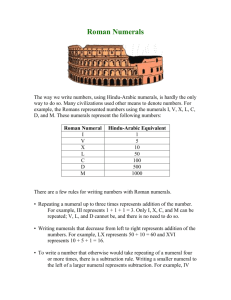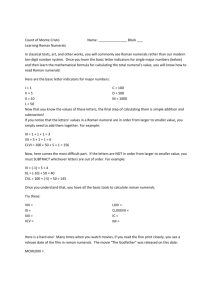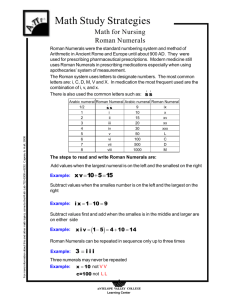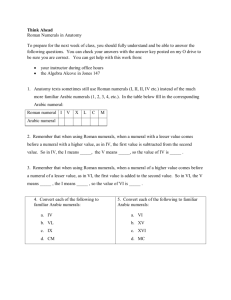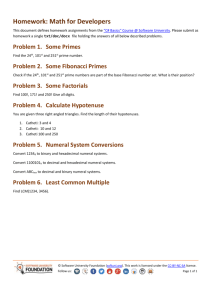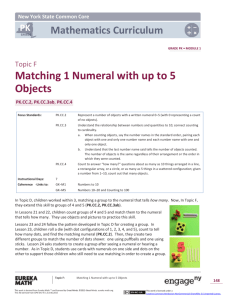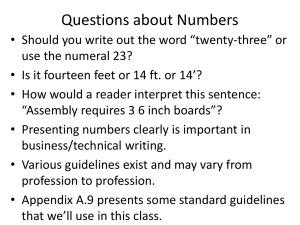The systems of numerals in Catalan Sign language (LSC)and
advertisement
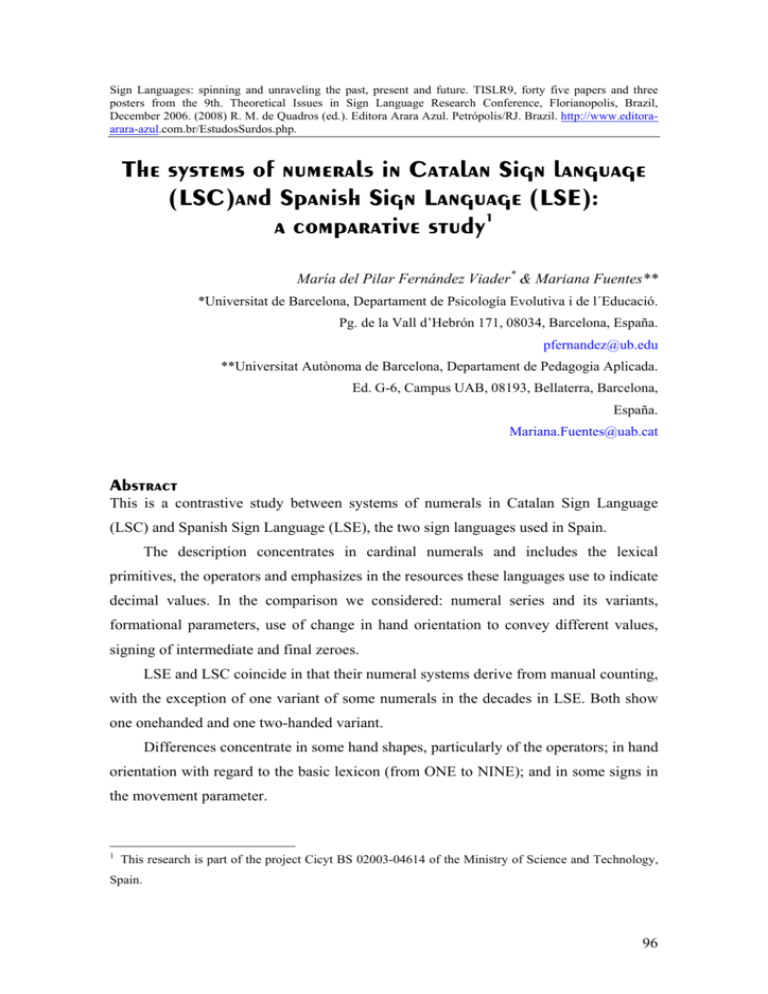
Sign Languages: spinning and unraveling the past, present and future. TISLR9, forty five papers and three posters from the 9th. Theoretical Issues in Sign Language Research Conference, Florianopolis, Brazil, December 2006. (2008) R. M. de Quadros (ed.). Editora Arara Azul. Petrópolis/RJ. Brazil. http://www.editoraarara-azul.com.br/EstudosSurdos.php. The systems of numerals in Catalan Sign language (LSC)and Spanish Sign Language (LSE): 1 a comparative study María del Pilar Fernández Viader* & Mariana Fuentes** *Universitat de Barcelona, Departament de Psicología Evolutiva i de l´Educació. Pg. de la Vall d’Hebrón 171, 08034, Barcelona, España. pfernandez@ub.edu **Universitat Autònoma de Barcelona, Departament de Pedagogia Aplicada. Ed. G-6, Campus UAB, 08193, Bellaterra, Barcelona, España. Mariana.Fuentes@uab.cat Abstract This is a contrastive study between systems of numerals in Catalan Sign Language (LSC) and Spanish Sign Language (LSE), the two sign languages used in Spain. The description concentrates in cardinal numerals and includes the lexical primitives, the operators and emphasizes in the resources these languages use to indicate decimal values. In the comparison we considered: numeral series and its variants, formational parameters, use of change in hand orientation to convey different values, signing of intermediate and final zeroes. LSE and LSC coincide in that their numeral systems derive from manual counting, with the exception of one variant of some numerals in the decades in LSE. Both show one onehanded and one two-handed variant. Differences concentrate in some hand shapes, particularly of the operators; in hand orientation with regard to the basic lexicon (from ONE to NINE); and in some signs in the movement parameter. 1 This research is part of the project Cicyt BS 02003-04614 of the Ministry of Science and Technology, Spain. 96 Key words: Numeral system-contrastive study-Spanish Sign Language-Catalan Sign LanguageWe performed a contrastive study of numeral systems in Catalan Sign Language (LSC) and Spanish Sign Language (LSE), concentrating in the cardinal series. Contrastive studies between these two languages are scarce and do not include comparisons between these two languages’ numeral systems. Because of this, this research aims to complete and deepen previous studies done on each of these languages separately (Fernández-Viader, M.P., Segimon, J.M.; Boronat, J.; Codorniu, I.; García, C.; Jarque, M.J.; Serrano, E., 1997; Fernández-Viader, M.P., Segimon, J.M.; Boronat, J.; Codorniu, I.; Frigola, S.; García, C.; Jarque, M.J.; Serrano, E., 2002; FernándezSoneira, 2000; 2003; Fuentes, M., 1999, 2000; Fuentes, M. y Tolchinsky, L., 2004; Pinedo, F., 1989). We consider that these studies are especially necessary nowadays when the Deaf Community in Spain is seeking the full recognition of its sign languages. Also, linguistic descriptions are the reference point in language acquisition studies. The description we present includes the phonological features of the basic lexicon of cardinal numerals: the lexical primitives, the operators, and some morphosyntactic compounds, and emphasizes in the resources the languages use to indicate decimal values. The description considers similarities and differences between LSC and LSE. Comparisson will consider: the numeral series and their variants, the formational parameters, use of change of hand orientation in each language to indicate different values, signing of intermediate and final zeroes, use of a sign ZERO as a place holder, transparency with regard to decimal notation and cardinality, lexicalization of certain numerals. This is a preliminary study and our conclusions are still not definitive, due to the scarcity of previous contrastive studies on these languages: LSE and LSC. Also, with regard to LSE, we are broadening the research to include informants from different regions of the country. 97 1. Method 1.1. Sources of data collection For LSC: – Consultation with informants. – Observations in deaf associations over a two year period. – Sign language courses. – Permanent consultation because of continued contact. – Study of dictionaries and LSC teaching materials. – Study of existing bibliography on the subject. For LSE: – Consultation with informants. – Study of dictionaries. – Study of existing bibliography on the subject. 1.2. Informants They were 9 deaf native signers in LSC, considered competent signers as they are or were sign language teachers and are part of the Deaf Community in Barcelona. With regard to LSE they were 3 native signers, and 2 hearing competent signers, sign language teachers. 1.3. Procedure Informants were asked to read a series of numerals written in Hindu-Arabic notation, and to record all the variants they knew of each numeral. They also answered questions concerning the contexts of use of numeral signs. Instruction was given in sign and in written form. All productions were video recorded. 98 1.4. Materials Three collections of numerals that included the complete series from one to twenty as well as a group of numerals chosen according to a set of criteria: number of digits; absolute and place values of the same number; presence or absence of internal and final zeros; and repeated or different digits. Some numerals were the first ones of a unit of order (e.g., 1,000). Many of numerals of the these collections were the same. The informants signed one of the three collections of numerals. We presented the numerals as a list, one under the other on a sheet of paper, or written on cards, one numeral on each card. We included the following instruction in Spanish: “Please sign all the correct signs—two, three, or more—for each of the numbers that follow” and “If there is more than one sign for a number, please show the two or more existing signs.” The same instruction was given in sign. 2. Analysis The analysis took into account the following parameters: hand-shape, orientation, location, and movement. As previously said we analized the basic lexicon, including lexical primitives, the operators and some morphosyntactic compounds. The analysis aims to compare both languages with reagard to the existence of one or more series of numerals and its variants, use of change of hand orientation to indicate different values, and use of the sign ZERO. 3. Description As a general feature, both languages distinguish between cardinal and ordinal use of numerals. Our description includes only the cardinal series, we are now comparing the ordinal numerals in both languages. Numeral signs in LSC and LSE present two variants: one is one handed and the other two handed. In the two cases the numeral lexicon derives mostly from manual counting, the same as in a great part of sign languages. Both language’s basic numeral lexicon includes signs for the nine digits, for the numerals zero and ten, and specific signs that function as operators or multipliers. These are HUNDRED, THOUSAND, MILLION, BILLION, and so on. The basic lexicon, signs ZERO, ONE to TEN, and operators, combine to form the rest of the numeral signs. LSE also includes special 99 names for some decades that do not derive from manual counting. We found differences in hand-shapes and hand orientation between LSC and LSE. 3.1. Numerals ZERO and ONE to TEN, two handed variant: Both languages sign ONE with the index finger extended, this means a difference with other number systems where ONE is signed with the thumb extended. Hand-shape of non-dominant hand is the same in LSC as in LSE. Dominant hand is distinctive. Hand-shape varies in some numerals: There are differences in signs SIX and SEVEN. In LSC, SIX is signed with the non-dominant hand and thumb of the dominant hand extended, SEVEN with the thumb and index fingers extended; in LSE, SIX is signed with the nondominant hand and index of the dominant hand extended, SEVEN with the nondominant hand and the index and the middle fingers of the dominant hand extended. Hand orientation also varies. We found that this parameter is stable in LSC: from ONE to FIVE, the palm faces the signer, from SIX to TEN the palm faces the interlocutor. In LSE we found that use of hand orientation does not vary from 1 to 10, the palm always faces the signer. Nevertheless, when the communication situation requires it, the orientation parameter changes and the palm faces the interlocutor . Also, we did not find agreement with regard to this parameter between informants. Nevertheless, an important difference with LSC is that hand orientation does not vary from ONE to TEN. For both languages location of numerals is a chest height, medial distance. With regard to movement, numerals ZERO and ONE to NINE are holdings, TEN may have local movement. SEVEN (LSC) SEVEN (LSE) 100 3.2. Numerals ZERO and ONE to TEN, one handed variant: Hand-shape: In LSC: SIX is signed with the extended thumb, SEVEN with the extended thumb and index, EIGHT with the thumb, index and middle fingers, NINE, with the index, middle, ring and little fingers. In LSE: SIX is signed in two movements: 1st dominant hand in FIVE, 2nd hand closes and extends index of the same hand. For SEVEN extends index and middle finger, for EIGHT, thumb, index and middle fingers and for NINE, index, middle, ring and little fingers. Hand orientation varies between languages, in LSC the palm faces the signer from ONE to FIVE, the palm faces the interlocutor from SIX to NINE. This is a very important feature of this language that allows to distinguish between numerals in the one handed variant (examples: Numerals THREE and EIGHT, numerals FOUR and NINE). In LSE the palm faces the signer from ONE to NINE (please take into account the statements made above for the two handed variant). Location is the same as the two handed variant. Movement: LSC: the wrist turns: the palm initially faces the signer, and then faces the interlocutor; in LSE, as explained before, has also a local movement but a different one: hand in FIVE closes and extends as many fingers as numerals over five, beginning with the index finger. 3.3. perators HUNDRED In LSC, we found two ways to sign numerals in the hundreds: HUNDRED as operator (Example: 103: HUNDRED-THREE) and a transparent2 way to sign (Example: 103: ONE-ZERO-THREE). In whole hundreds -it is, hundreds with no decades or units without grouping, for example: 100, 200- we found a lexicalization and a change of 2 We mean, the signer signs the face value of the numerals in the units, decades and cents place. For example: 123: ONE-TWO-THREE. 101 orientation in the non-zero digit. In LSE there are three variants for signing numerals in the hundreds. Two of them are operators that function as numeral incorporating roots3. The third is transparent. THOUSAND The signs for thousand differ completely between the two languages. In LSC there are three variants; one is a numeral incorporating root. In LSE there are four variants; one is the same as in LSC. Two of them are numeral incorporating roots. MILLION The signs vary in all parameters between both languages. MILLION (LSC) MILLION (LSE) 3.4. Morphosintactic compounds Operators show changes in units of order and its use is obbligatory in both languages: from thousands ownwards in LSC and from hundreds ownwards in LSE. In LSC, TEN does not function as operator, it is, 11 is signed ONE-ONE and not TEN-ONE. In LSE the same happens between 11 and 15. Nevertheless, in this language, from 16 to 19 TEN does function as operator: to perform the numerals between 16 and 19, one signs one variant of numeral TEN, that includes a special movement and then as many units 3 In many sign languages, there are roots capable to incorporate numeral hand-shapes in its phonetic form to indicate the number of things to be counted. This phenomenon is described as numeral incorporation. Each sign has two morphemes: the classifier root and the numeral hand-shape (Massone y Machado, 1994). 102 as needed in the two handed variant: so for example 16 is signed TEN-SIX. In both languages, when the operator sign is absent –in LSC always in tens, sometimes in hundreds, in LSE sometimes in tens and sometimes in hundreds-, the only clue for place value is the order when signing, the displacement to the signer’s right while signing each digit, and use of the sign ZERO when necessary. So, in the decades’ unit of order, we sign first the numeral for the decades and then the numeral for the units. In the hundreds’ unit of order, we sign first the numeral for the hundreds, then the numeral for the decades and then the numeral for the units. Use of sign ZERO to indicate decimal values in both languages is a common feature of these sign languages that differs from spoken languages and deserves being emphasized. SIXTEEN (LSC) SIXTEEN (LSE) 4. Conclusions 103 This is a preliminary study and our conclusions are still not definitive. Nonetheless, the following results can be presented at this stage: 104 The similarities can be summarised as follows: • both languages have cardinal numerals with at least two variants, • one one-handed and the other two-handed; numeral signs from ONE to TEN derive from manual counting; both languages use a ZERO sign as a place holder; ONE is signed with the index extended; in both of the numeral TWENTY (the sign differs in LSE and in LSC) that does not derive from manual counting. Main differences are the following: A major difference regarding the cardinal series in the two languages is the variation between contexts. In LSC, cardinal numeral signs are signed in the same way regardless of the context of use, but in LSE the signs change if the signer is referring to time, to money or to concrete objects. Another difference lies in a phonological aspect: hand orientation. In LSC its use is stable and always has a numerical meaning: in one-handed numerals it indicates differences in cardinal meaning (for example: numeral signs NINE and FOUR in the one handed variant only differ in orientation). In LSE, hand orientation does not seem to be a distinctive feature (indeed, its use varies between informants). Future research should focus on: Hybrid productions, with both operators and use of intermediate zeros, in both languages. In LSE from hundreds upwards we found hybrid variants with both operators and use of internal zeros at the same time. In LSC from thousands upwards we found hybrid variants. The corpus should be enlarged with more informants in different contexts of use and in other regions of the country. We have started on the study of numeral incorporation roots and ordinal series and use of numerals in different measurement units in both languages. Contrastive analysis of both languages would also allow us to obtain data for language teaching and educational intervention with these language users. Our special thanks to all our informants. 105 References Fernández Soneira, A. & Martínez Fuentes, S. (2003). La incorporación numeral en las lenguas signadas. Revista de Investigación Lingüística, 1, Vol VI: 67-86. Fernández Soneira, A. (2000) El número y la cuantificación en la lengua de señas española, Tesis de licenciatura no publicada. Fernández-Viader, M.P.; Segimon, J.M.; Boronat, J.; Codorniu, I.; García, C.; Jarque, M.J.; Serrano, E. (1997). Signem LSC! 1-2. Barcelona: ILLESCAT. Fernández-Viader, M.P., Segimon, J.M.; Boronat, J.; Codorniu, I.; Frigola, S.; García, C.; Jarque, M.J.; Serrano, E. (2002). Aprenem LSC! 1-2. Barcelona: ILLESCAT. Fuentes, M. (1999). La comprensión y producción de numerales en niños sordos. PhD Unpublished Dissertation. University of Barcelona, Spain. Fuentes, M. (2000). Los numerales en la Lengua de Signos Catalana. Sintagma, 12: 19- 35. Fuentes,M. y Tolchinsky,L. (2004). The subsistem of numerals in Catalan Sign Language: Description and examples from a psycholinguistic study. Sign Language Studies, Vol 5, Nº 1:94-117. Massone, M.A. y Machado, E.M. (1994). Lengua de Señas Argentina: Análisis y Vocabulario Bilingüe. Buenos Aires, Edicial. Pinedo, F.,(1989).Nuevo Diccionario Gestual Español. Madrid: Fomento del empleo minusválidos. 106

